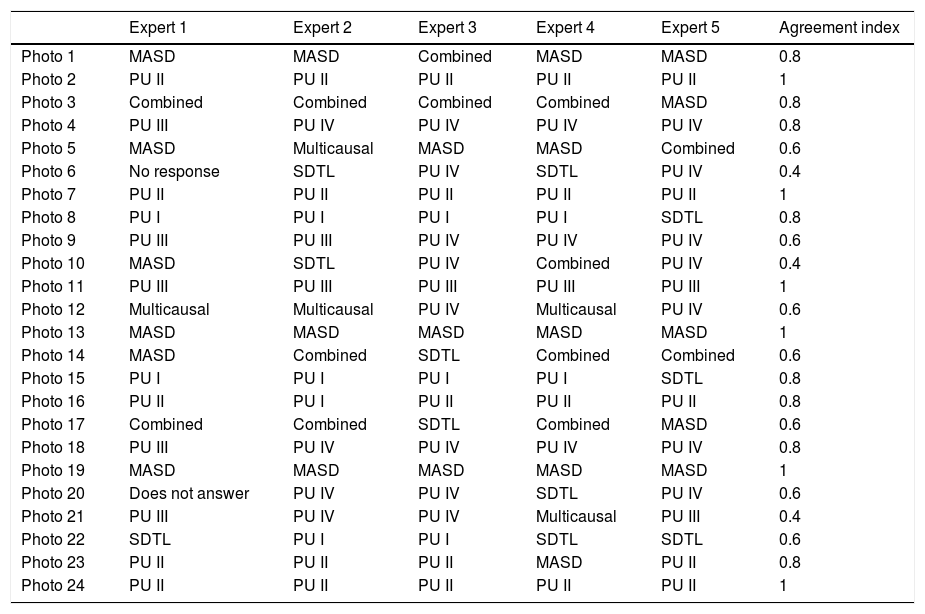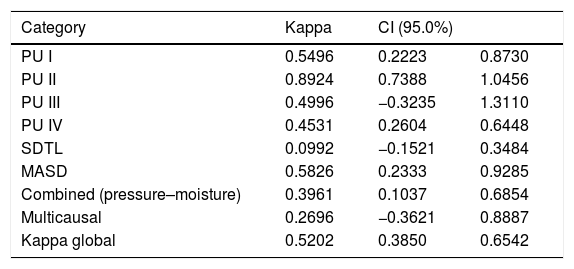To examine the reliability of the classification of dependence-related lesions using photography.
MethodA panel of 5 experts carried out a blind, anonymous and independent assessment of 24 photographs. Images were sent by electronic mail, together with an anonymous questionnaire that was sent back to a referee of the research group. We suggested 8 options for classification: pressure ulcer (categories I, II, III, IV, or ‘suspect of deep-tissue damage’), moisture-associated damage, pressure-moisture combined aetiology and multifactorial lesion. Concordance index was calculated for every photography. Cohen`s Kappa index with ‘jackknife’ technique were calculated for every photograph and category. We used the statistical programme Epidat 4.2.
ResultsObserved agreement was variable, between 4 and 1 depending on the photography. A consensus of 100 % was observed in 6 images. Global Kappa resulted as moderate:.5202 (IC95 %:.3850–.6542). Intra-group concordance resulted moderate in 4 categories, low in 3, and high only for pressure ulcer category II (Kappa.8924. IC 95 %:.7388–1.0456). Inter-observer concordance was.6602 (IC 95 %: .4969–.8081).
ConclusionsThe reliability of the use of photographs for the categorization of dependence-related lesions is moderate, being higher for category II pressure ulcers and low formore complex wounds. This method must be used with care, and education on the subject is required.
Examinar la fiabilidad de la clasificación de lesiones relacionadas con la dependencia según su etiología mediante fotografías.
MétodoSe constituyó un panel de 5 expertas que evaluaron 24 fotografías de forma anónima, independiente y ciega, emitiendo un juicio para cada una de ellas. Las fotografías se enviaron por correo electrónico, junto con un cuestionario anónimo que se devolvió a un referente del grupo. Se propusieron 8 opciones de clasificación: úlceras por presión categorías I, II, III y IV, “sospecha de lesión de tejidos profundos”, “lesión asociada a la humedad”, etiología mixta presión-humedad y etiología multicausal. Se calculó el índice de acuerdo para cada fotografía y el coeficiente Kappa con técnica “jackknife” para cada imagen y cada categoría de clasificación, usando el paquete estadístico Epidat 4.2.
ResultadosLos índices de acuerdo observado fueron variables, entre 0,4 y 1 dependiendo de la fotografía. En 6 ocasiones se obtuvo un 100% de acuerdo observado. El coeficiente Kappa global resultó moderado: 0,5202 (IC95%: 0,3850- 0,6542). El coeficiente de concordancia intraclase resultó moderado en 4 de las categorías y bajo en 3 de ellas, siendo alto solamente en úlceras por presión categoría II (Kappa 0,8924. IC 95%: 0,7388-1,0456). La concordancia entre observadoras resultó 0,6602 (IC 95%: 0,4969-0,8081).
ConclusionesLa fiabilidad del uso de fotografías para la categorización de lesiones relacionadas con la dependencia resulta moderada, siendo mayor en úlceras por presión categoría II y baja en lesiones de mayor complejidad. Este método, debe ser usado con cautela en la categorización de lesiones crónicas, siendo necesario impulsar acciones formativas.








